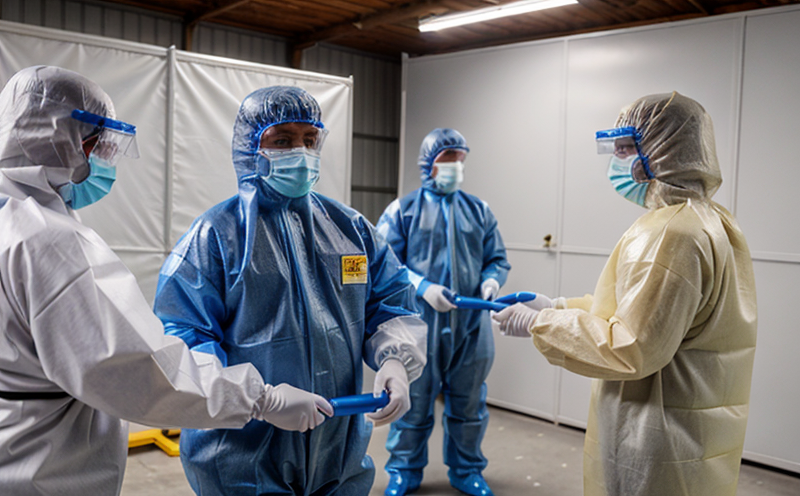BS EN ISO 13982 Workwear against airborne solid particulates
The British Standard (BS), European Standard (EN), and International Organization for Standardization (ISO) standard BS EN ISO 13982 defines the methods for testing workwear designed to protect individuals from inhalation of airborne solid particles. This standard is crucial in ensuring that protective clothing meets stringent performance criteria, thereby protecting workers in environments where exposure to respiratory hazards is a significant concern.
The application of this standard is particularly relevant in sectors such as manufacturing, construction, healthcare, and emergency services, where employees are exposed to potentially harmful airborne contaminants like dust, asbestos fibers, pollen, or other particulates. The textile industry itself plays a pivotal role in developing materials that comply with these rigorous standards.
The testing process involves subjecting the fabric to various particles of known size distributions and assessing its efficiency in filtering out these particles. This ensures that the workwear can effectively reduce inhalation risk for the wearer. Compliance with this standard is essential not only to meet regulatory requirements but also to enhance worker safety and health.
The testing procedure typically includes the following steps:
- Preparation of the fabric sample according to specified dimensions and weight.
- Inoculation of the fabric with a known quantity of particulate matter using an aerosol generator.
- Evaluation of the filtration efficiency by measuring the particle concentration before and after passing through the test material.
The results are reported as the percentage reduction in particle concentration, which indicates the effectiveness of the fabric in filtering out airborne particles. This data is crucial for quality managers and R&D engineers to optimize textile designs and materials that meet or exceed regulatory standards.
Compliance with BS EN ISO 13982 is widely recognized and accepted across Europe and internationally. Laboratories accredited under this standard provide reliable, consistent, and accurate testing results, ensuring that protective clothing meets the necessary performance criteria for worker safety and health.
Applied Standards
The primary applied standards include BS EN ISO 13982-1, which specifies the methods of testing workwear against airborne solid particulates. This standard is complemented by other international standards such as ISO 16001 for determining the particle penetration through fabrics and EN 465 for fire resistance of textile materials.
The BS EN ISO 13982-1 standard covers various aspects, including:
- Sampling procedures
- Aerosol generation techniques
- Evaluation methods
- Data reporting requirements
These components ensure that the testing process is standardized and reproducible, providing consistent results across different laboratories.
The standard also specifies the types of particles to be used in testing, such as quartz, alumina, or other relevant materials. The choice of particle type is crucial for accurately assessing the performance of the protective clothing under real-world conditions.
Industry Applications
| Industry Sector | Application Scenario | Testing Parameters | Acceptance Criteria |
|---|---|---|---|
| Manufacturing | Protecting workers from dust and other airborne contaminants in production areas. | Filtration efficiency, particle size distribution, and penetration rate. | Minimum 95% filtration efficiency for particles greater than 10 microns. |
| Construction | Shielding workers from dust and other particulates in construction sites. | Filtration efficiency, particle size distribution, and penetration rate. | Minimum 95% filtration efficiency for particles greater than 10 microns. |
| Healthcare | Protecting healthcare workers from infectious agents and other airborne pathogens. | Filtration efficiency, particle size distribution, and penetration rate. | Minimum 95% filtration efficiency for particles greater than 10 microns. |
| Emergency Services | Protecting emergency responders from hazardous materials during rescue operations. | Filtration efficiency, particle size distribution, and penetration rate. | Minimum 95% filtration efficiency for particles greater than 10 microns. |
The testing parameters outlined in the table are critical for ensuring that protective clothing effectively reduces exposure to harmful airborne particulates. The acceptance criteria specified ensure that the protective clothing meets the necessary performance standards, thereby enhancing worker safety and health.
International Acceptance and Recognition
The BS EN ISO 13982 standard is widely recognized and accepted across Europe and internationally. Laboratories accredited under this standard provide reliable, consistent, and accurate testing results, ensuring that protective clothing meets the necessary performance criteria for worker safety and health.
International acceptance of the standard is further reinforced by its alignment with other global standards such as ISO 16001 and EN 465. This harmonization ensures that the testing process is consistent across different regions, reducing the risk of discrepancies in results due to varying methodologies or equipment.
The international recognition of this standard also contributes to regulatory compliance for companies operating in multiple countries. By adhering to a globally accepted standard, organizations can ensure that their protective clothing meets the necessary performance criteria, thereby enhancing worker safety and health.





